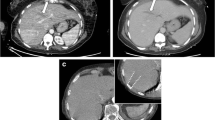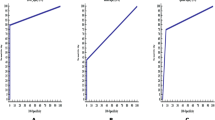Abstract
Purpose of Review
This review describes the current role of diagnostic and interventional radiology in the management of solid organ trauma, particularly the role of non-operative endovascular interventions such as angioembolization (AE). We will also provide a brief highlight of interventions available for thoracic trauma.
Recent Findings
There has been a paradigm shift over the past 2 decades in the management of solid organ injuries from surgical management to non-operative management, especially in cases of minor injuries. Many factors, including the advances in multidetector contrast enhanced CT (MD-CECT) imaging, demands of cost-effective healthcare, and innovation of minimally invasive interventions with lower complication rates than surgical laparotomy have all contributed to this shift. Interventional radiology now plays a crucial role in the management of solid organ trauma, focusing on less invasive endovascular therapies. In addition, the grading and triaging of patients with stable solid organ traumatic injuries has become more reliant on MD-CECT findings.
Summary
This review article highlights the common imaging findings, grading systems, and most current management guidelines for solid organ trauma with a brief highlight of thoracic trauma.










Similar content being viewed by others
References
Papers of particular interest, published recently, have been highlighted as: • Of importance •• Of major importance
Centers for Disease Control and Prevention, National Center for Injury Prevention and Control. Web-based Injury Statistics Query and Reporting System (WISQARS) http://www.cdc.gov/injury/wisqars. Published 2007. Accessed January 10, 2017.
Raza M, Abbas Y, Devi V, Prasad KV, Rizk KN, Nair PP. Non operative management of abdominal trauma: a 10 years review. World J Emerg Surg. 2013;8:14.
Fang JF, Wong YC, Lin BC, Hsu YP, Chen MF. Usefulness of multidetector computed tomography for the initial assessment of blunt abdominal trauma patients. World J Surg. 2006;30(2):176–82.
Cox EF. Blunt abdominal trauma. A 5-year analysis of 870 patients requiring celiotomy. Ann Surg. 1984;199(4):467–74.
Marmery H, Shanmuganathan K, Alexander MT, Mirvis SE. Optimization of selection for nonoperative management of blunt splenic injury: comparison of MDCT grading systems. AJR Am J Roentgenol. 2007;189:1421–7.
•• Stassen NA, Bhullar I, Cheng JD, Crandall ML, Friese RS, Guillamondegui OD, et al. Selective nonoperative management of blunt splenic injury: an Eastern Association for the Surgery of Trauma practice management guideline. J Trauma Acute Care Surg. 2012;73:S294–300. The above reference outlines and highlights the most current guidelines for management of blunt splenic trauma
•• Stassen NA, Bhullar I, Cheng JD, Crandall M, Friese R, Guillamondegui O, et al. Nonoperative management of blunt hepatic injury: an Eastern Association for the Surgery of Trauma practice management guideline. J Trauma Acute Care Surg. 2012;73:S288–93. The above reference outlines and highlights the most current guidelines for management of blunt hepatic injury
ACR appropriateness criteria: https://acsearch.acr.org/docs/69409/Narrative/
Korner M, Krotz MM, Degenhart C, Pfeifer K-J, Reiser MF, Lisenmaier U. Current role of emergency US in patients with major trauma. Radiographics. 2008;28:255–44.
Branney SW, Wolfe RE, Moore EE, et al. Quantitative sensitivity of ultrasound in detecting free intraperitoneal fluid. J Trauma. 1995;39:375–80.
• Soto JA, Anderson SW. Multidetector CT of blunt abdominal trauma. Radiology. 2012;265:678–93. The above reference describes important MD-CT findings seen in blunt abdominal organ trauma
Anderson SW, Varghese JC, Lucey BC, et al. Bluntsplenictrauma: delayed- phase CT for differentiation of active hemorrhage from contained vascular injury inpatients. Radiology. 2007;243(1):88–95.
Peng MY, Parisky YR, Cornwell EE, Radin R, Bragin S. CT cystography versus conventional cystography in evaluation of bladder injury. AJR Am J Roentgenol. 1999;173(5):1269–72.
Chan DP, Abujudeh HH, Cushing GL, Novelline RA. CT cystography with multiplanar reformation for suspected bladder rupture: experience in 234 cases. AJR Am J Roentgenol. 2006;187(5):1296–302.
Orwig D, Federle MP. Localized clotted blood as evidence of visceral trauma on CT: the sentinel clot sign. AJR Am J Roentgenol. 1989;153(4):747–9.
Federle MP, Jeffrey RB. Hemoperitoneum studied by computed tomography. Radiology. 1983;148(1):187–92.
Levine CD, Patel UJ, Silverman PM, Wachsberg RH. Low attenuation of acute traumatic hemoperitoneum on CT scans. AJR Am J Roentgenol. 1996;166(5):1089–93.
Hassan R, Abd Aziz A, Md Ralib AR, Saat A. Computed tomography of blunt spleen injury: a pictorial review. Malays J Med Sci. 2011;18:60–7.
King H, Shumacker HB. Splenic studies. I. Susceptibility to infection after splenectomy performed in infancy. Ann Surg. 1952;136(2):239–42.
Renzulli P, Gross T, Schnüriger B, et al. Management of blunt injuries to the spleen. Br J Surg. 2010;97(11):1696–703.
• Moore EE, Cogbill TH, Jurkovich GJ, Shackford SR, Malangoni MA, Champion HR. Organ injury scaling: spleen and liver (1994 revision). J Trauma. 1995;38(3):323–4. The above reference includes the most current AAST organ injury scaling for traumatic splenic and liver injuries
Kokabi N, Waqas S, Xing M, Harmouche E, Wilson K, Johnson JO, et al. Intra-abdominal solid organ injuries: an enhanced management algorithm. Can Assoc Radiol J. 2014;65:301–9.
Frandon J, Rodière M, Arvieux C, Michoud M, Vendrell A. BrouxC, et al. blunt splenic injury: outcomes of proximal versus distal and combined splenic artery embolization. Diagn Interv Imaging. 2014;95(9):825–31.
Haan JM, Bochicchio GV, Kramer N, Scalea TM. Nonoperativemanagement of blunt splenic injury: a 5-year experience. JTrauma. 2005;58(3):492–8.
Gaarder C, Dormagen JB, Eken T, Skaga NO, Klow NE, Pillgram-Larsen J, et al. Nonoperative management of splenic injuries: improved results with angioembolization. J Trauma. 2006;61(1):192–8.
Bessoud B, Denys A, Calmes JM, etal. Nonoperative management of traumatic splenic injuries: is there a role for proximal splenic artery embolization? AmJ Roentgenol 2006;186:779–785.
Raikhlin A, Baerlocher MO, Asch MR, et al. Imaging and transcatheter arterial embolization for traumatic spleen icinjuries: review of the literature. Can J Surg. 2008;51:464–72.
Wu SC, Chen RJ, Yang AD, etal. Complications associated with embolization in the treatment of blunt splenic injury. World J Surg 2008; 32:476–482.
• Imbrogno BF, Ray CE. Splenic artery embolization in blunt trauma. Semin Interv Radiol. 2012;29(2):147–9. The above reference describes the most current indications and technique for splenic artery embolization in blunt trauma
Schnüriger B, Inaba K, Konstantinidis A, Lustenberger T, Chan LS, Demetriades D. Outcomes of proximal versus distal splenic artery embolization after trauma: a systematic review and meta-analysis. J Trauma. 2011;70:242–60.
Steichen FM. Hepatic trauma in adults. Surg Clin North Am. 1975;55:387–407.
Yoon W, Jeong YY, Kim JK, et al. CT in blunt liver trauma. Radiographics. 2005;25:87–104.
Patten RM, Spear RP, Vincent LM, Hesla RB, Jurkovich GJ. Traumatic laceration of the liver limited to the bare area: CT findings in 25 patients. AJR Am J Roentgenol. 1993;160(5):1019–22.
Fleming KW, Lucey BC, Soto JA, Oates ME. Posttraumatic bile leaks: role of diagnostic imaging and impact on patient outcome. Emerg Radiol. 2006;12(3):103–7.
Salazar GMM, Walker TG. Evaluation and management of acute vascular trauma. Tech Vasc Interv Radiol. 2009;12:102–16.
Schwartz RA, Teitelbaum GP, Katz MD, Pentecost MJ. Effectiveness of transcatheter embolization in the control of hepatic vascular injuries. J Vasc Interv Radiol. 1993;4(3):359–65.
Kandarpa K, Machan L, editors. Handbook of interventional radiologic procedures. 4th ed. Philadelphia, PA: Lippincott Williams & Wilkins; 2011.
Alonso RC, Nacenta SB, Martinez PD, et al. Kidney in danger: CT findings of blunt and penetrating renal trauma. Radiographics. 2009;29(7):2033–53.
Ramchandani P, Buckler PM. Imaging of genitourinary trauma. AJR Am J Roentgenol. 2009;192(6):1514–23.
Santucci RA, McAninch JW, Safir M, Mario LA, Service S, Segal MR. Validation of the American Association for the Surgery of Trauma organ injury severity scale for the kidney. J Trauma. 2001;50(2):195–200.
• Moore EE, Shackford SR, Pachter HL, et al. Organ injury scaling: spleen, liver, kidney. J Trauma. 1989;29(12):1664–6. The above reference outlines and describes the most current AAST organ injury scaling for traumatic renal injuries
Harris AC, Zwirewich CV, Lyburn ID, Marchinkow LO. CT findings in blunt renal trauma. Radiographics. 2001;21:S201–14.
Sauk S, Zuckerman DA. Renal artery embolization. Semin Interv Radiol. 2011;28:396–406.
• Mani N, Kim L. Role of interventional radiology in urologic tract trauma. Semin Interv Radiol. 2011;28:415–23. The above reference outlines the most current indications and technique for IR management of traumatic kidney injuries
Cirillo RL, Koniaris LG. Detecting blunt pancreatic injuries. J Gastrointest Surg. 2002;6:587–98.
Kao LS, Bulger EM, Parks DL, Byrd GF, Jurkovich GJ. Predictors of morbidity after traumatic pancreatic injury. J Trauma. 2003;55:898–905.
Venkatesh SK, Wan JM. CT of blunt pancreatic trauma: a pictorial essay. Eur J Radiol. 2008;67:311–20.
Gupta A, Stuhlfaut JW, Fleming KW, Lucey BC, Soto JA. Blunt trauma of the pancreas and biliary tract: a multimodality imaging approach to diagnosis. Radiographics. 2004;24:1381–95.
Madiba TE, Mokoena TR. Favourable prognosis after surgical drainage of gunshot, stab, or blunt trauma of the pancreas. Br J Surg. 1995;82:1236–9.
Linsenmaier U, Wirth S, Reiser M, Körner M. Diagnosis and classification of pancreatic and duodenal injuries in emergency radiology. Radiographics. 2008;28:1591–601.
Moore EE, Cogbill TH, Malangoni MA, Jurkovich GJ, et al. Organ injury scaling, II: pancreas, duodenum, small bowel, colon, and rectum. J Trauma. 1990;30(11):1427–9.
Heitsch RC, Knutson CO, Fulton RL, Jones CE. Delineation of critical factors in the treatment of pancreatic trauma. Surgery. 1976;80(4):523–9.
Jones RC. Management of pancreatic trauma. Ann Surg. 1978;187:555–64.
Fisher M, Brasel K. Evolving management of pancreatic injury. Curr Opin Crit Care. 2011;17:613–7.
Canty TG, Weinman D. Treatment of pancreatic duct disruption in children by an endoscopically placed stent. J Pediatr Surg. 2001;36:345–8.
Bradley EL, Young PR, Chang MC, Allen JE, Baker CC, Meredith W, et al. Diagnosis and initial management of blunt pancreatic trauma: guidelines from a multiinstitutional review. Ann Surg. 1998;227:861–9.
The American College of Surgeons Committee on Trauma Leadership. In: Clark DE, Fantus RJ, editors. National Trauma Data Bank (NTDB) annual report. Chicago: Ill: American College of Surgeons; 2007. p. 1–64.
Report on injuries in America: all unintentional injuries, 2005. Available at: http://www.nsc.org/library/report_table_1.htm. Accessed December 9, 2007.
Livingston DH, Haurer CJ. Trauma to the chest wall and lung. In: Moore EE, Feliciano DV, Mattox KL, editors. Trauma. 5th ed. Philadelphia, Pa: McGraw-Hill; 2004. p. 507–37.
Kaewlai R, Avery LL, Asrani A, Novelline RA. Multidetector CT of blunt thoracic trauma. Radiographics. 2008;28:1555–70.
Exadaktylos AK, Sclabas G, Schmid SW, Schaller B, Zimmermann H. Do we really need routine computed tomographic scanning in the primary evaluation of blunt chest trauma in patients with “normal” chest radiograph? J Trauma. 2001;51:1173–6.
Hagiwara A, Yanagawa Y, Kaneko N, Takasu A, et al. Indications for transcatheter arterial embolization in persistent hemothorax caused by blunt trauma. J Trauma. 2008;65:589–94.
Author information
Authors and Affiliations
Corresponding author
Ethics declarations
Conflict of Interest
Frank Kowalkowski Jr., Gurpreet Sandhu, and Indravadan Patel declare that they have no conflict of interest.
Human and Animal Rights and Informed Consent
This article does not contain any studies with human or animal subjects performed by any of the authors.
Additional information
This article is part of the Topical Collection on Vascular Interventional Radiology
Rights and permissions
About this article
Cite this article
Kowalkowski, F., Sandhu, G. & Patel, I.J. Role of Interventional Radiology in Solid Organ Trauma. Curr Trauma Rep 3, 212–222 (2017). https://doi.org/10.1007/s40719-017-0091-1
Published:
Issue Date:
DOI: https://doi.org/10.1007/s40719-017-0091-1




